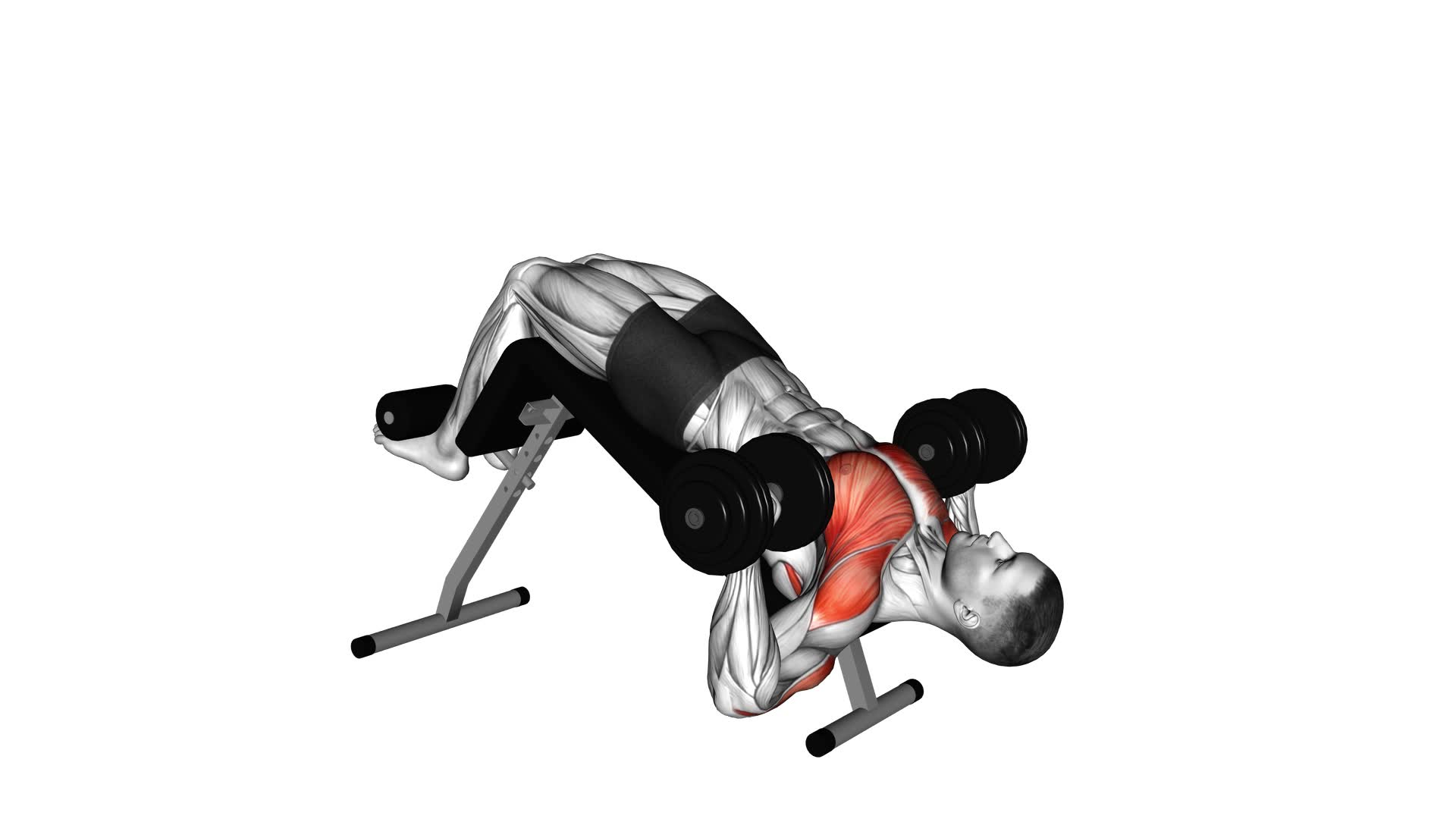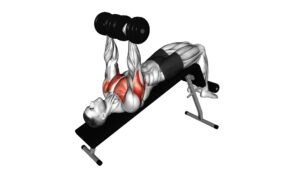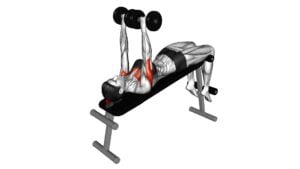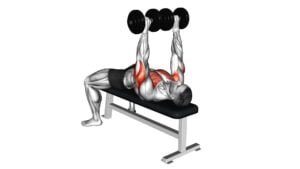Dumbbell Single Arm Alternate Decline Bench Press – Video Exercise Guide & Tips

Get ready to take your workout to the next level with the dumbbell single arm alternate decline bench press!
Watch This Exercise Video
This video exercise guide and tips will show you the proper form and technique, as well as provide variations and progressions to keep you challenged.
With this exercise, you'll target multiple muscles and build strength and definition.
Stay safe and get ready to feel the burn with this effective and efficient workout.
Let's get started!
Key Takeaways
- Proper form and technique are essential for a safe and effective dumbbell single arm alternate decline bench press.
- Using a decline bench and dumbbells challenges each arm independently and allows for a greater range of motion.
- The exercise primarily targets the lower chest muscles, but also engages the shoulders, triceps, and stabilizer muscles.
- It is important to listen to your body, start with a comfortable weight, and gradually increase weight as strength improves to prevent injury.
Proper Form and Technique
Maintain a stable and controlled position while performing the Dumbbell Single Arm Alternate Decline Bench Press to maximize its benefits and advantages. Common mistakes can hinder your progress and increase the risk of injury, so it's crucial to focus on proper form and technique.
One common mistake is using too much weight. It's important to start with a weight that you can handle comfortably, allowing you to maintain proper form throughout the exercise. This will help you target the muscles effectively and minimize strain on your joints.
Another mistake is arching your back excessively. To avoid this, engage your core muscles and maintain a neutral spine throughout the movement. This will help you maintain stability and prevent unnecessary strain on your lower back.
Incorporating proper breathing technique is also essential. Remember to exhale as you push the dumbbell up and inhale as you lower it down. This will provide stability and help you maintain control throughout the exercise.
Equipment and Set-Up
To properly set up for the Dumbbell Single Arm Alternate Decline Bench Press, you'll need a decline bench and a pair of dumbbells. Having the right equipment is essential to ensure proper form and maximize the benefits of this exercise.
The importance of using the proper equipment can't be overstated. A decline bench is specifically designed to target the lower chest muscles, allowing for a greater range of motion. This angle activates the muscles in a different way compared to a flat or incline bench, helping to develop strength and definition in the lower chest.
Using dumbbells instead of a barbell adds an extra challenge to the exercise. With dumbbells, each arm has to work independently, which helps to improve muscle balance and stability. It also allows for a greater range of motion, engaging more muscle fibers in the chest, shoulders, and triceps.
When setting up the decline bench, ensure that it's at a decline angle of around 20-30 degrees. This angle will target the lower chest effectively. Adjust the bench height to a comfortable position and make sure it's stable and secure.
Finally, select an appropriate pair of dumbbells that challenge your muscles without compromising your form. Start with a weight that allows you to perform the exercise with proper technique and gradually increase the weight as you gain strength and confidence.
Targeted Muscles
To effectively target your muscles during the Dumbbell Single Arm Alternate Decline Bench Press, focus on activating your lower chest, shoulders, and triceps. This exercise primarily works the muscles in your chest, specifically the lower portion. By performing the movement on a decline bench, you increase the emphasis on the lower chest muscles. Additionally, your shoulders and triceps play a significant role in stabilizing and pressing the dumbbells.
The Dumbbell Single Arm Alternate Decline Bench Press offers several benefits for your upper body. Firstly, it helps to develop strength and definition in your lower chest, giving your chest a more complete and balanced appearance. Secondly, it targets your shoulders, aiding in the development of rounded and sculpted deltoids. Lastly, the exercise engages your triceps, contributing to overall arm strength and size.
By incorporating the Dumbbell Single Arm Alternate Decline Bench Press into your workout routine, you can effectively target and strengthen your lower chest, shoulders, and triceps. This exercise is a great addition to any upper body workout, helping you achieve a well-rounded and sculpted physique.
Now, let's move on to the next section and explore some variations and progressions of this exercise.
Variations and Progressions
Try incorporating different variations and progressions of the Dumbbell Single Arm Alternate Decline Bench Press to challenge your muscles and continue making progress in your upper body workouts. Here are some options for you to consider:
- Different Grips: Experiment with using a neutral grip, where your palms face each other, or a pronated grip, where your palms face away from you. These variations can target different muscles in your chest and arms, providing a fresh stimulus for growth.
- Progressive Overload: Increase the weight you use over time to continuously challenge your muscles and encourage them to grow stronger. This can be done by gradually adding more weight to the dumbbell or by using a weighted vest or chains to increase resistance.
- Tempo Variations: Altering the speed at which you perform the exercise can change the intensity and focus on different muscle fibers. Try slowing down the lowering phase of the movement (eccentric) or pausing at the bottom of the press to increase time under tension.
- Superset or Drop Set: Incorporate the decline bench press into a superset or drop set routine to add an extra challenge. Supersets involve performing two exercises back-to-back with little to no rest in between, while drop sets involve reducing the weight after reaching failure to push your muscles to their limits.
- Single Arm Decline Bench Press with Resistance Bands: If you don't have access to dumbbells or want to change things up, you can use resistance bands instead. Attach the bands to the bench or an anchor point and perform the exercise as you'd with dumbbells.
Safety and Precautions
As you incorporate different variations and progressions of the Dumbbell Single Arm Alternate Decline Bench Press into your upper body workouts, it's important to prioritize safety and take necessary precautions. By being mindful of common mistakes and practicing injury prevention techniques, you can minimize the risk of accidents and ensure a safe and effective workout.
One common mistake to avoid is using too much weight. It's important to start with a weight that you can comfortably handle and gradually increase it as your strength improves. Using excessive weight can put strain on your muscles and joints, increasing the risk of injury.
Another mistake to watch out for is improper form. When performing the Dumbbell Single Arm Alternate Decline Bench Press, it's crucial to maintain proper alignment of your body. Keep your back flat against the bench, engage your core, and avoid excessive arching or rounding of your spine. This will help to protect your lower back and maintain stability throughout the exercise.
In addition, make sure to warm up properly before starting your workout. This can help to increase blood flow to your muscles, improve flexibility, and reduce the risk of injury. Incorporating dynamic stretches and mobility exercises specific to the muscles involved in the Dumbbell Single Arm Alternate Decline Bench Press can be beneficial.
Remember to listen to your body and rest when needed. Overtraining or pushing through pain can lead to injuries. If you experience any discomfort or pain during the exercise, stop immediately and consult a fitness professional or healthcare provider.
Frequently Asked Questions
How Many Repetitions and Sets Should I Do for the Dumbbell Single Arm Alternate Decline Bench Press?
For the dumbbell single arm alternate decline bench press, the number of repetitions and sets will depend on your fitness goals and current strength level.
It's generally recommended to start with 3-4 sets of 8-12 repetitions per arm.
Focus on maintaining proper form and technique throughout the exercise to maximize results and prevent injury.
Remember to consult with a fitness professional for variations and modifications tailored to your specific needs.
Can I Use a Flat Bench Instead of a Decline Bench for This Exercise?
Yes, you can use a flat bench instead of a decline bench for the dumbbell single arm alternate decline bench press.
However, it's recommended to use a decline bench for this exercise because it provides a greater range of motion and targets the lower chest muscles more effectively.
Using a decline bench also helps to engage your core muscles and maintain stability during the exercise.
Is It Necessary to Have a Spotter While Performing the Dumbbell Single Arm Alternate Decline Bench Press?
Yes, it's necessary to have a spotter while performing the dumbbell single arm alternate decline bench press.
Having a spotter ensures your safety and helps you maintain proper form throughout the exercise.
They can assist you in lifting the weights and prevent any accidents or injuries.
It's always recommended to have a spotter when performing any heavy or challenging exercises to maximize your workout and minimize the risk of injury.
Can I Perform This Exercise With a Barbell Instead of Dumbbells?
Yes, you can perform the exercise with a barbell instead of dumbbells. However, using dumbbells offers several benefits.
Dumbbells allow for a greater range of motion, engage stabilizer muscles, and provide balanced strength development. Additionally, using dumbbells reduces the risk of muscle imbalances and allows for unilateral training.
How Do I Know if I Am Using the Correct Weight for This Exercise?
To choose the right weight for exercises, start with a weight that challenges you, but allows you to maintain proper form. Avoid using weights that are too heavy, as this can lead to injury.
Common mistakes during weightlifting include using improper form and lifting weights that are too heavy. Remember, it's better to start with lighter weights and gradually increase as you get stronger.
Listen to your body and adjust accordingly.
Conclusion
In conclusion, the dumbbell single arm alternate decline bench press is an effective exercise that targets the chest, shoulders, and triceps. It can be performed with proper form and technique using a decline bench and dumbbells.
By gradually increasing the weight and incorporating variations, individuals can progress and challenge their muscles further. However, it's important to prioritize safety and take precautions, such as using a spotter and starting with lighter weights to avoid injury.

Author
Years ago, the spark of my life’s passion ignited in my mind the moment I stepped into the local gym for the first time. The inaugural bead of perspiration, the initial endeavor, the very first surge of endorphins, and a sense of pride that washed over me post-workout marked the beginning of my deep-seated interest in strength sports, fitness, and sports nutrition. This very curiosity blossomed rapidly into a profound fascination, propelling me to earn a Master’s degree in Physical Education from the Academy of Physical Education in Krakow, followed by a Sports Manager diploma from the Jagiellonian University. My journey of growth led me to gain more specialized qualifications, such as being a certified personal trainer with a focus on sports dietetics, a lifeguard, and an instructor for wellness and corrective gymnastics. Theoretical knowledge paired seamlessly with practical experience, reinforcing my belief that the transformation of individuals under my guidance was also a reflection of my personal growth. This belief holds true even today. Each day, I strive to push the boundaries and explore new realms. These realms gently elevate me to greater heights. The unique combination of passion for my field and the continuous quest for growth fuels my drive to break new ground.







